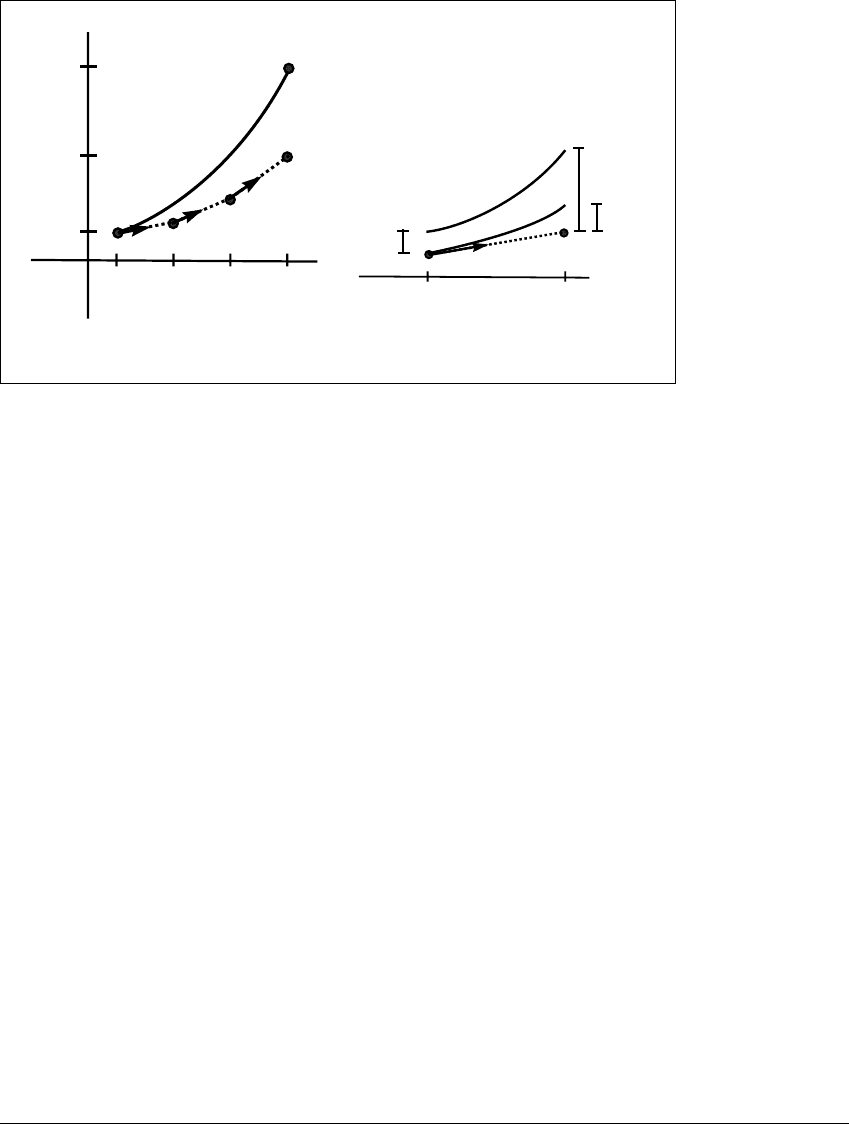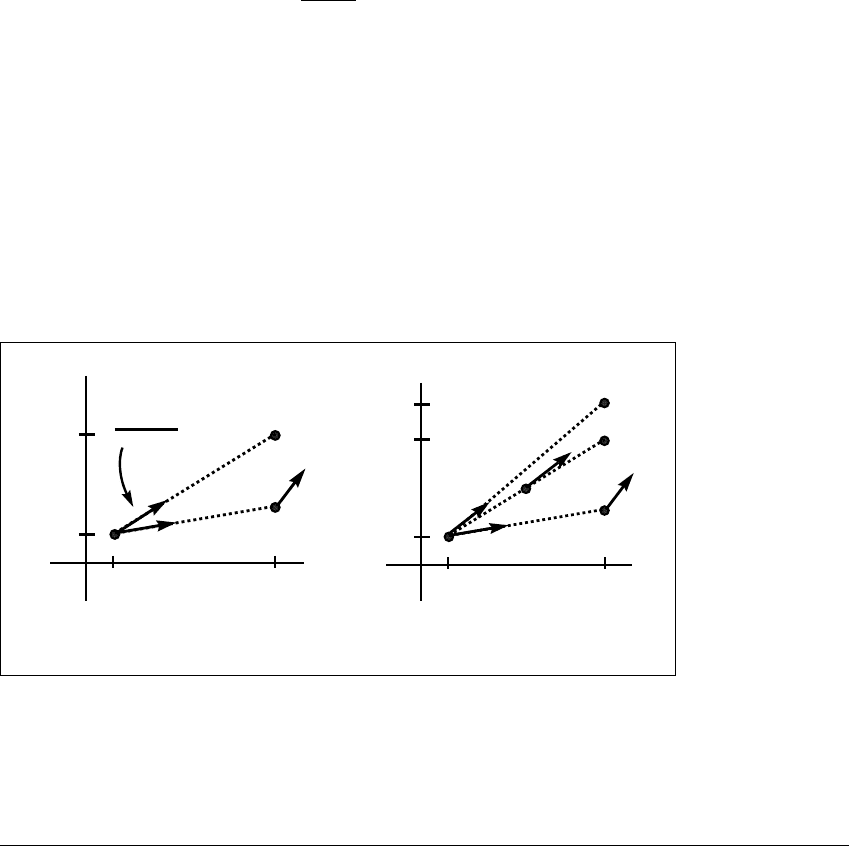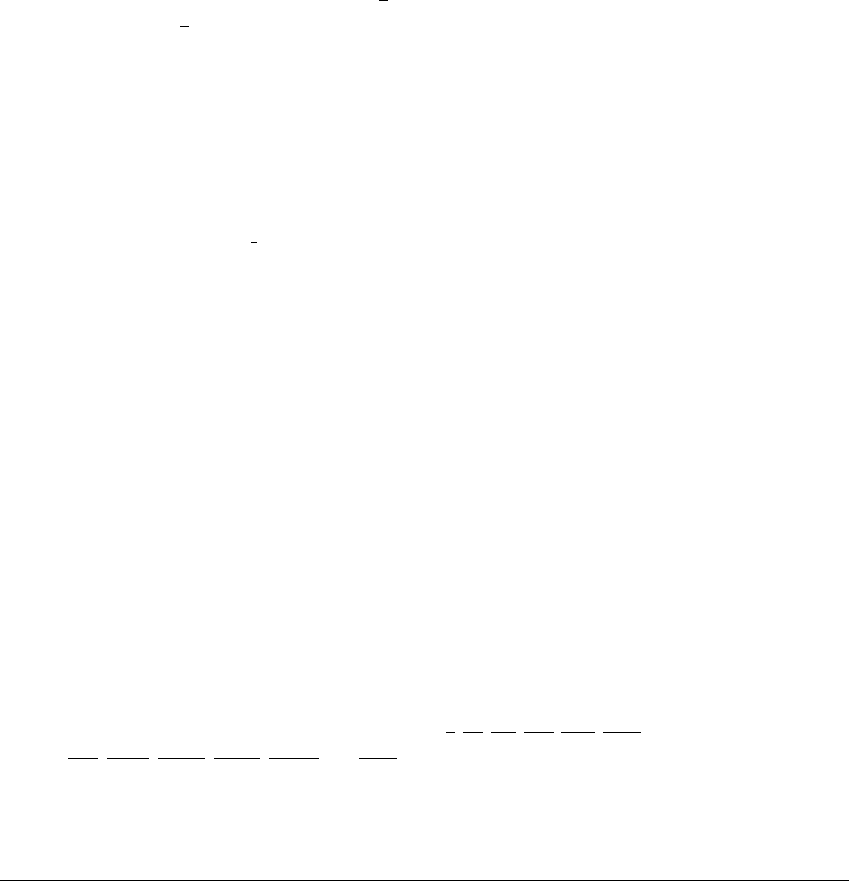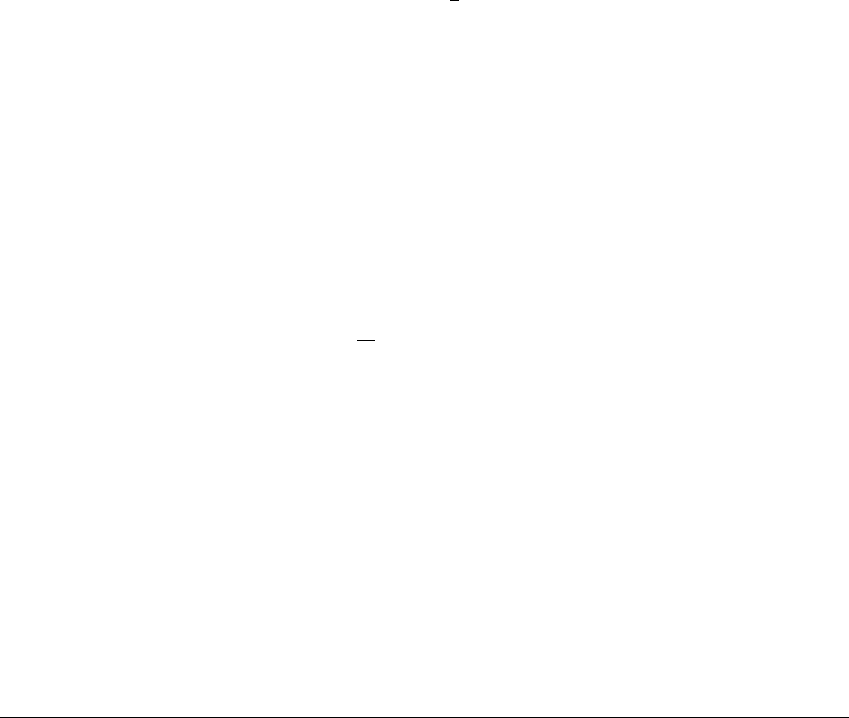Alligood K., Sauer T., Yorke J.A. Chaos: An Introduction to Dynamical Systems
Подождите немного. Документ загружается.


B.2 ERROR IN N UMERICAL I NTEGRATION
x
3
w
3
x
0
t
0
t
1
t
2
t
3
e
n+1
E
n+1
E
n
t
n
t
n+1
(a) (b)
Figure B.1 Output from an ODE solver.
(a) The Euler method follows a line segment with the slope of the vector field at
the current point to the next point. The upper curve represents the true solution to
the differential equation. (b) The total error E
n⫹1
is the total of the one-step error
e
n⫹1
and accumulated error from previous steps.
After one step, the total error E
1
is the same as the one-step error e
1
.The
total error E
2
after two steps has two contributions. First, because of the error E
1
,
the right side f of the differential equation is going to be sampled at an incorrect
point w
1
instead of x
1
. Second, a new one-step error e
2
will be made because of
the discretization of the derivative. As Figure B.1(b) shows, the new total error
E
2
will have a contribution from the accumulated error from the previous step as
well as a new one-step error.
The output of the Euler method is w
n
⫽ x
0
(1 ⫹ ah)
n
for n ⱖ 0. The true
solution is x
n
⫽ x
0
e
ahn
, so that the difference is
E
n
⫽ x
n
⫺ w
n
⫽ x
0
e
ahn
⫺ x
0
(1 ⫹ ah)
n
⫽ x
0
e
ahn
⫺ x
0
(1 ⫹ ah)
n⫺1
e
ah
⫹ x
0
(1 ⫹ ah)
n⫺1
e
ah
⫺ x
0
(1 ⫹ ah)
n
⫽ e
ah
⭈ x
0
(e
ah(n⫺1)
⫺ (1 ⫹ ah)
n⫺1
) ⫹ w
n⫺1
(e
ah
⫺ (1 ⫹ ah)). (B.6)
We recognize E
n⫺1
, the total error at step n ⫺ 1, and e
n
, the one-step error at
step n , in the above equation. If we set A ⫽ e
ah
, we can write the result in the
following general form.
571

C OMPUTER S OLUTION OF ODES
TOTAL E RROR FOR AN ODE SOLVER
E
n
⫽ AE
n⫺1
⫹ e
n
In this expression, the term A is the amplification factor. It depends on the
method being used and the particular differential equation. If A ⬇ 1, one expects
the total error to be approximately the sum of the one-step errors. For IVPs that
are sensitive to initial conditions, however, the amplification factor is commonly
greater than one. For system (B.1), this case holds when a ⬎ 0.
The order of an ODE solver is a measure of its relative accuracy. Let t
0
be
the initial time of the IVP, and let t
e
⬎ t
0
be a later time. By definition, the order
of an ODE solver is k if the total error evaluated at t
e
is
E ⬇ Ch
k
(B.7)
for small h. More precisely, one requires
lim
h→0
E
h
k
⬍
⬁
.
Order measures the dependence of the total error on the stepsize h, and is helpful
in a relative way. It gives no absolute estimate of the error, but it tells us that the
error of a second-order method, for example, would decrease by a factor of 4 if we
cut the step size in half (replace h by h 2 in (B.7)). This concept of order is used
to rank methods by accuracy.
The order of an ODE solver can be informally determined by expressing
the one-step error in terms of h. Using the differential equation (B.3), the Taylor
expansion of the solution at t
0
can be written
x(t
0
⫹ h) ⫽ x
0
⫹ h
˙
x(t
0
) ⫹
h
2
2
¨
x(t
0
) ⫹⭈⭈⭈
⫽ x
0
⫹ hf(t
0
,x
0
) ⫹
h
2
2
f
x
(t
0
,x
0
) ⫹
f
t
⫹⭈⭈⭈. (B.8)
Comparing with the Euler’s method approximation (B.4), we find the one-step
error e
1
to be proportional to h
2
, where terms of higher degree in h are neglected
for small h. To find the order of the method, subtract one from the power of h in
the one-step error. The reasoning is as follows. Assuming that the amplification
factor is approximately one, the simplest case, the total error made by the ODE-
solver between t
o
and t
e
will be approximately the sum of the one-step errors.
572

B.2 ERROR IN N UMERICAL I NTEGRATION
The number of steps needed to reach the desired time t
e
grows as h decreases: It
is proportional to h
⫺1
. The total error for the Euler method, as a function of h,
should therefore be proportional to h
2
⭈ h
⫺1
⫽ h
1
. On this basis, the Euler method
is of order one. Cutting the step size in half results in cutting the total error in
half.
Higher order methods can be derived by more elaborate versions of the
reasoning used in the Euler method. The modified-Euler method is
z
0
⫽ x
0
z
n⫹1
⫽ z
n
⫹ h
s
1
⫹ s
2
2
for n ⱖ 1, (B.9)
where s
1
⫽ f(t
n
,z
n
)ands
2
⫽ f(t
n
⫹ h, z
n
⫹ hs
1
). It can be checked that the one-
step error for this method is ⬇ h
3
(see, for example, (Burden and Faires, 1993)).
Figure B.2(a) shows one step of the method along with the roles of s
1
,whichis
the slope of f as in the Euler method, and s
2
, which is the slope at t
n⫹1
,wherethe
Euler method is used as a guess for x
n⫹1
. Instead of taking the Euler method step,
the two slopes s
1
and s
2
are averaged, and a step is taken with the averaged slope.
This is a simple predictor-corrector method, in which the Euler method is used
to predict the new solution value, followed by a more accurate correction. Note
that the correction cannot be made without knowing the prediction.
t
n
t
n+1
z
n
z
n+1
s
2
s
1
s
1
+ s
2
2
t
n
t
n+1
z
n
z
n+1
s
2
s
1
s
3
w
n+1
s
3
(a) (b)
Figure B.2 The geometry of a higher-order one-step method.
(a) The Modified Euler method takes an Euler step whose slope is the average of
the two slopes shown. (b) A third-order method first uses modified Euler to find the
vector field in the middle of the time interval, and translates the slope s
3
determined
there back to t
n
. Then an Euler step is taken with slope s
3
to produce (t
n⫹1
,w
n⫹1
).
573

C OMPUTER S OLUTION OF ODES
B.3 ADAPTIVE STEP-SIZE METHODS
Thus far we have treated the step size h as a constant throughout the calculation.
We have given no advice on how to choose h, except to say that the smaller the
h, the smaller the error. Adaptive methods find the best step size automatically,
and constantly recalculate the optimal size as the calculation proceeds.
Matlab’s ode23 program is an adaptive method using second-order modi-
fied Euler along with the third-order method
w
0
⫽ x
0
w
n⫹1
⫽ w
n
⫹ h
s
1
⫹ 4s
3
⫹ s
2
6
for n ⱖ 1, (B.10)
where s
1
and s
2
are as defined for the modified Euler method and s
3
⫽ f(t
n
⫹
h 2,w
n
⫹ (h 2)(s
1
⫹ s
2
) 2). As sketched in Figure B.2(b), the average slope
used to calculate z
n⫹1
in the Euler-type step in the modified Euler method is used
instead to sample the differential equation for a new slope at t
n
⫹ h 2. This slope
is used for the Euler-type step from t
n
to t
n⫹1
.
To get the program to adjust the step size h automatically, the user must set
a tolerance TOL for the one-step error. For the new step, both the second-order
approximation z
n⫹1
from (B.9) and the third-order approximation w
n⫹1
from
(B.10) are calculated. Since the third-order approximation is so much better, the
difference between the two is a good approximation for the one-step error of z
n⫹1
,
that is, e(h) ⬇ |z
n⫹1
⫺ w
n⫹1
|. Denote by c the factor by which we want to change
the step size. Then the new step size should be the ch that satisfies TOL ⫽ e(ch),
which can be approximated as follows:
TOL ⫽ e(ch) ⬇ c
3
e(h) ⬇ c
3
|z
n⫹1
⫺ w
n⫹1
|. (B.11)
Here we have used the fact that the one-step error of the (second-order) modified
Euler method is proportional to h
3
. Now (B.11) can be solved for c:
c ⫽
TOL
|z
n⫹1
⫺ w
n⫹1
|
1 3
. (B.12)
Two further points make the automatic choice of step size conservative. First, the
new h is set to be 0.9ch instead of ch. Second, although the step size is being set
to keep one-step error within the preset tolerance for the second-order method,
the third-order approximation w
n⫹1
is accepted as the new value of the solution.
Matlab also provides a higher-order adaptive method called ode45.This
is an implementation of the Runge-Kutta-Fehlberg method. It uses a variation
574

B.3 ADAPTIVE S TEP-SIZE M ETHODS
of the fourth-order Runge-Kutta method described above together with a fifth-
order method that can be accomplished while reusing some of the fourth-order
calculations, in the same spirit as ode23. This method, often denoted RK45 in
other sources, is very popular for applications in which running time is not a
critical factor.
Depending on your intended use, we have either completely solved the
problem of computational solution of differential equations, or have barely
scratched the surface. One-step methods are fine for the simulations we have
outlined in this book, but are too slow for industrial-strength applications. A
rough way to compare the computational effort required for ODE methods is to
count the number of times per step that f, the right-hand side of the equation,
needs to be evaluated.
As we saw in the above code fragment, fourth-order Runge-Kutta requires
four function evaluations per step, for a one-dimensional system. It is not hard
to derive multistep methods that are fourth order but require only one function
evaluation per step. A multi-step ODE method uses not only the previous esti-
mate w
n
, but several previous estimates w
n
,w
n⫺1
,... to produce w
n⫹1
. In fact,
it is fairly wasteful of one-step methods to ignore this available information. If
most of the computational effort lies in the evaluation of f, we would expect a
fourth-order multistep method to run four times as fast as RK4.
Multistep methods have some liabilities. The most obvious is that starting
the method is nontrivial. Usually, a one-step method is used to intialize the pre-
vious w
i
estimates that are needed. Second, when adaptive step sizing is used, the
fact that the previous estimates w
n
,w
n⫺1
,...are not equally spaced complicates
the formulas significantly. A new generation of methods called multivalue ODE
methods has recently been introduced to alleviate some of these problems. We
refer you to a current numerical analysis textbook, such as (Burden and Faires,
1993) to read more about these issues.
575

Answers and Hints to
Selected Exercises
T1.2 Hint: Mimic the proof of Part 1.
T1.3 The points in the open intervals (⫺1, 0) and (0, 1) satisfy |f(x)| ⬎ |x|,and
converge to sinks ⫺1 and 1, respectively. The points |x| ⬎
5 satisfy |f(x)| ⬎ |x|,
and because they increase the distance from the origin on each iteration they
cannot converge to either of the sinks.
T1.4 One condition is that f lies strictly between the lines y ⫽ p and y ⫽ x in (p ⫺
⑀
,
p ⫹
⑀
).
T1.5 兵1 ⫹
2, 1 ⫺
2其.
T1.7 兵(5 ⫹
5) 8, (5 ⫺
5) 8其.
T1.8 f
k
has 2
k
fixed points. Some are also fixed points of period less than k, but since
2
k
⫺ (2
k⫺1
⫹ 2
k⫺2
⫹ ...⫹ 2
1
) ⫽ 2, not all can have period less than k.
577

A NSWERS AND H INTS TO S ELECTED E XERCISES
T1.10 If x is eventually periodic, then 3
m
x ⫽ 3
n
x (mod 1). Since (3
m
⫺ 3
n
)x is an integer
p, x ⫽ p (3
m
⫺ 3
n
) is a rational number. Conversely, assume x ⫽ p q,wherep
and q are integers. The integers 3
m
p cannot all be distinct modulo q, since there
are only q possibilities. For some integers m and n,3
m
p ⫽ 3
n
p (mod q), which
implies 3
m
p q ⫽ 3
n
p q (mod 1).
T1.14 (a) Any number between (2 ⫺
!
2 ⫹
2) 4and(2⫺
2) 4 will do.
T1.16 (a) Greater than 1 2 (b) Less than 1 2.
1.1 l has an attracting fixed point if and only if ⫺1 ⬍ a ⬍ 1, and has a repelling
fixed point if and only if a ⬍⫺1ora ⬎ 1. There is a fixed point that is neither
attracting nor repelling if a ⫽⫺1, and many such if a ⫽ 1andb ⫽ 0. If a ⫽ 1
and b ⫽ 0, the map l has no fixed point.
1.3 x ⫽ 0 is a source.
1.5 Source.
1.9 (a)
2. (b) ⫺
2 and all preimages of ⫺1. Hints: Draw the graph and show that
except for the undefined orbit with x
0
⫽⫺1, all orbits that ever reach outside
[⫺1.5, ⫺1.4] converge to
2. Note that the endpoints of this interval both map
to ⫺1, so the remainder of the orbit (and limit) is undefined. Next show that
any point inside this interval is repelled from ⫺
2 at the rate of more than a
factor of 4 per iterate, so that no orbit other than the fixed orbit 兵⫺
2其 can
avoid eventually leaving the interval. Most leave the interval and converge to
2; a few unlucky ones land on ⫺1.5or⫺1.4 on the way out and end up with
undefined orbits.
1.11 (b) Hint: Show that (f
2
)
(x) ⱖ 0forallx.
1.15 The only fixed point is x ⫽ 0. Orbits with initial conditions in [⫺1, 0] are
attracted to 0; all other orbits diverge.
1.16 Hint: Check for n ⫽ 0. To prove the formula for n ⫽ 1, you may need the
double-angle formula: cos 2x ⫽ 1 ⫺ 2sin
2
x.
T2.4 Hint: Write the vector in polar coordinates and use the sin and cos addition laws.
T2.7 (b) ⫺1. (d) ⫺1.
T2.8 The inverse map is g(x, y) ⫽ (y, (x ⫺ a ⫹ y
2
) b). If b ⫽ 0, then the points (1, 0)
and (1, 1) map to the same point, so the map is not one-to-one.
T2.9 (b) Part (a) confirms that the orbit of any point on S stays on S, a parabola through
0. Since the x-coordinate of the orbit is halved each iteration, it converges to 0,
and the y coordinate must follow.
T2.10 The axes of AN are of length 4 3and1 3 along the directions (2, 1) and (1, ⫺2),
respectively.
578

A NSWERS AND H INTS TO S ELECTED E XERCISES
2.1 (a) Source (b) Saddle (c) Sink.
2.2 (0, 0).
2.3 (0, 0) is a saddle and (3, 9) is a source.
2.4 (a) (⫺0. 7, ⫺0.7) is a fixed sink, (⫺0.8, ⫺0.8) is a fixed saddle; there are no
period-two orbits. (b) (⫺0.7, ⫺0.7) and (0.3, 0.3) are saddles and 兵(0.5, ⫺0.1),
(⫺0.1, 0.5)其 is a period-two sink orbit.
2.7 (a) ⫺0.1225 ⬍ a ⬍ 0.3675 (b) 0.3675 ⬍ a ⬍ 0.9125
2.8 (a) Image ellipse has one axis of length 2
2inthedirection(1, 1), and another
of length 1
2inthe(⫺1, 1) direction. Area is 2
. (b) Ellipse has axes of
length 3 and 2, and area of 6
.
T3.2 Hint: Find the Lyapunov exponents of all fixed points, and then show that all
orbits either are unbounded or converge to one of the fixed points.
T3.3 If f has a period-n orbit, then f
n
(x
0
) ⫽ x
0
⫹ nq ⫽ x
0
(mod 1), so that nq is an
integer. That is not possible since q is irrational. The Lyapunov exponent of the
orbit of any x
0
is lim
n→
⬁
1
n
[ln 1 ⫹ ...⫹ ln 1] ⫽ 0.
T3.4 The set of points which share the same length-k itinerary is a single subinterval
of length 2
⫺k
. An infinite itinerary corresponds to the nested intersection of
subintervals of length 2
⫺k
,kⱖ 1, which is a single point.
T3.7 First check that T
n
(x) ⫽ x if and only if G
n
C(x) ⫽ C(x), for any positive integer
n.Ifx is a period-k point for T,thenT
k
(x) ⫽ x implies G
k
C(x) ⫽ C(x). The
equality G
n
C(x) ⫽ C(x) cannot hold for any n ⬍ k because it would imply
T
n
(x) ⫽ x, which is not true—x is a period-k point. Therefore C(x)isaperiod-k
point for G.
T3.8 The first statement of Theorem 3.11 is Exercise T3.7. Secondly, apply the
chain rule to the equation g
k
(C(x)) ⫽ C(f
k
(x)) to get (g
k
)
(C(x))C
(x) ⫽
C
(f
k
(x))(f
k
)
(x). Since f
k
(x) ⫽ x and C
(x) ⫽ 0, cancelling yields (g
k
)
(C(x)) ⫽
(f
k
)
(x).
T3.10 (a) The itinerary LRR ⭈⭈⭈R, consisting of one L and k ⫺ 1R’s, is not periodic for
any period less than k. (b) According to Corollary 3.18, the interval LRR ⭈⭈⭈RL
contains a fixed point of f
k
. By part (a), that point must be part of a period-k
orbit.
T3.12 The twelve distinct periodic orbits of period ⱕ 5are:
L, KL, JKL, KLL, JKLL, KLLL,
IJKL, JKLLL, KLLLL, KLJKL, KLKLL,andIJKLL.
3.1 (a) a
1
⫽⫺1 4. (b) ⫺
⬁
.(c)a
2
⫽ 3 4. (d) a
3
⫽ 5 4. (e) First find an interval
which maps onto itself. Then find a partition as was done for the logistic map G.
579

A NSWERS AND H INTS TO S ELECTED E XERCISES
3.3 (a) G maps [0, 1] onto itself and g maps another interval onto itself. C will be a
one-to-one continuous map between [0, 1] and the other domain interval.
3.4 Hint: See Exercise T3.2.
3.5 (b) [1, 2] and [2, 3]. (c) The transition graph is the fully connected graph on two
symbols. There exists periodic points of all periods.
3.8 (a) All positive integers except 3, 5, and 7. (b) All positive integers.
3.9 (c) All positive integers.
3.10 All positive integers except for 3.
3.11 (b) Hint: Explain why either f or f
2
must have points 0 ⱕ x
1
⬍ x
2
ⱕ 1suchthat
x
1
maps to 0 and x
2
maps to 1.
3.12 Hint: Find a positive lower bound for f
on [0, 1].
T4.2 The expansions end in 0
2.
T4.7 Complete the square by replacing w ⫽ x ⫺ 1 2.
T4.8 Hint: Count the number of boxes needed to cover a square contained in (respec-
tively, containing) the disk.
T4.9 1 ⫹ ln 2 ln 3.
T4.10 (b) 1.
T4.11 (a) 0. (b) 1.
4.1 (a) Hint: Define f(x) ⫽ 3x. Show that f is a one-to-one function from one set
onto the other.
4.2 (a) 1. (b) In base 4 arithmetic, all numbers whose expansions use only 0 and 3.
(c) 1 5 ⫽ .
03, and 17 21 is also in K(4). (d) 0, 1 2. (e) a ⫽ 4.
4.4 Hint: Consider a family 兵Q
n
其 of intervals such that the nth rational is contained
in Q
n
and the length of Q
n
is
⑀
(2
n
), for each n, n ⱖ 1.
4.8 ln 2 ln 3.
4.11 (a) True. Prove for a union of two sets, then generalize. (b) False.
4.12 (a) Hint: Find out the distance between points 1 (n ⫹ 1) and 1 n. Show that
N(
⑀
) ⫽ 2n for
⑀
⫽ 1 n(n ⫹ 1).
4.13 (a) 1/(1⫹p). (b) 0.
T5.1 (2 3)
n
.
T5.4 Catmap:2;Ik
´
eda map: 1 ⫹ .51 .72 ⬇ 1.7.
580

A NSWERS AND H INTS TO S ELECTED E XERCISES
T5.6 (3 4, 1 3) and (1 4, 2 3); there are no others.
5.1 Since J
n
⫽ Df(v
n⫺1
) ⭈⭈⭈Df(v
0
), the matrix J
n
J
T
n
has determinant D
2n
.(The
determinant is unchanged under the transpose operation.) Since the prod-
uct of the m eigenvalues of J
n
J
T
n
is D
2n
, the product of the semimajor axes
of J
n
U is r
n
1
⭈⭈⭈r
n
m
⫽ |D|
n
. Therefore (r
n
1
)
1 n
⭈⭈⭈(r
n
m
)
1 n
⫽ |D| for n ⱖ 1, and
L
1
⭈⭈⭈L
m
⫽ [lim
n→
⬁
(r
n
1
)
1 n
] ⭈⭈⭈[lim
n→
⬁
(r
n
m
)
1 n
] ⫽ |D|, assuming the Lyapunov
numbers exist.
5.2 The Lyapunov numbers will be the absolute values of the eigenvalues of the
symmetric defining matrix, which are (1 ⫾
5) 2. The Lyapunov exponents are
ln(1 ⫹
5) 2 and ln(
5 ⫺ 1) 2. These are smaller than the cat map Lyapunov
exponents by a factor of 2 because the cat map matrix is the square of this one.
5.6 Hint: Design a two-sided symbol sequence that contains every finite subsequence
of L and R on both sides. There is a positive Lyapunov exponent as explained in
Section 5.6.
5.7 (b) The unit circle r ⫽ 1. (c) Orbits on the unit circle have Lyapunov exponents
ln 2 and ln 2. Orbits inside the unit circle have Lyapunov numbers 0 and 0, so
the Lyapunov exponents do not exist.
T6.2 Yes; consider G(x) ⫽ 4x(1 ⫺ x).
T6.3 (b) Hint: You will need to find the symbol sequence of a dense orbit. Any
neighborhood of a point in the invariant set of the horseshoe contains a block
determined by specifying a finite number of symbols to the left and to the right of
the decimal point. Proceed, as in the construction of a dense orbit for the logistic
map g
4
, by listing every finite block of symbols, ordered by length.
T6.6 Hint: Points in the attractor A can be assigned two–sided symbol sequences
just as points in the chaotic set of the horseshoe map. Notice that the orbit of
a point in the solenoid depends entirely on its t coordinate. Specifically, code
points symbolically by the following rule: the ith symbol is 0 if the t coordinate
of f
i
(t, z)isin[0,
1
2
); otherwise, the ith symbol is 1. Show that any neighborhood
of a point in A can be represented by a symbol block with a finite number of
symbols specified to the right and to the left of the decimal point. (The symbols
to the right determine a neighborhood of the t coordinate, while those to the
left determine on which local branch the point is located.) Then follow the
construction for a dense orbit in the horseshoe.
T6.7 Hint: Construct an orbit similar to the dense orbit in the tent map T
2
or the
logistic map g
4
, which includes all allowable symbol sequences, ordered by length.
6.1 Hint: See Exercise T6.2.
6.2 Figure 6.10(a): All positive integers. Figure 6.13(a): All positive integers. Figure
6.14(a): All even positive integers.
581
